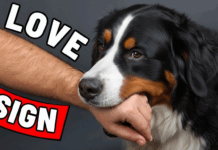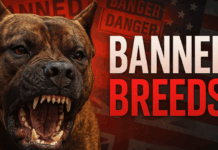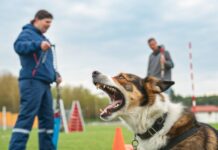Last Updated on June 25, 2021 by Dogs Vets
How Dogs Communicate – Everything You Need To Know
Dogs use facial and body language to communicate just like humans. But because dogs are equipped with four legs and a tail, their body language is very different from ours.
Taking the time to observe your dog’s movements and activities can be hugely beneficial to your happiness and that of your dog, allowing you to recognize stress or discomfort and react to potential problems before they escalate.
How to communicate with your dog
Can dogs understand the human language?
Dogs are social creatures that live together and therefore need dog language to communicate. The way dogs communicate with each other is based on a system of shared signals.
Obviously, dogs cannot talk, so their ‘language’ is made up of other signals – mainly body language, such as ear and tail movements and positioning, as well as how the dog positions itself around other dogs.

Your dog’s ancestors survived by forming packs that hunted together, defended their young puppies together, and protected territory from outsiders.
And while two people can get along, adding more people to a group increases the chance of arguments. Constant fighting and injuries weaken the group. Survival depends on all the dogs and puppies in the group staying healthy and productive.
Dog language allows dogs to not only communicate and understand each other. It’s also a system used to resolve conflicts, including calming signals that helps them to move away from fighting.
In fact, once you understand how dogs communicate and how they interpret verbal and silent body language, you’ll be able to communicate better with your pup.
Do dogs understand each other when they bark?
Dogs can also learn to use their barking in a specific context. Dogs bark to communicate with other dogs and people. It does not have the same meaning as words in human language, but it represents a type of communication that indicates the emotional state of the barking dog.
What Scientist Think About Dog Barking
A dog’s vocalizations may not sound very sophisticated. Raymond Coppinger pointed out that most dog vocalizations consist of barking and that the barking seems to be involuntary. Coppinger reported on a dog whose job was to freely guard livestock.

The dog barked continuously for seven hours, even though no other dogs were within miles. If the barking is communicative, the dogs would not bark if no one could hear them.
To Coppinger, it seemed that the dog was simply relieving some internal arousal.
The pattern of arousal is that dogs don’t have much control over their barking. They do not consider their audience, and their barks have little information other than the emotional state of the barking dog.
Perhaps barking is another by-product of domestication. Unlike dogs, wolves rarely bark. Barking accounts for only 3 percent of wolf vocalizations.
Meanwhile, experimental foxes in Russia [bred to obey] bark when they see humans, but control foxes do not.
Frequent barking, when aroused, is likely to be another consequence of choosing against aggression.
But newer research suggests that there may be more to barking than we first thought. Dogs have quite plastic vocal cords, or “changeable vocal cords“. Dogs may be able to subtly change their voices to produce many different sounds, which could have different meanings.
Dogs can even change their voices in ways that are obvious to other dogs but not to humans. When scientists have made spectrograms or pictures of dog barks, it turns out that not all barks are the same – even those of the same dog.
Depending on the context, a dog’s bark can vary in timing, pitch, and amplitude. Perhaps they have different meanings.
I know two Australian dogs, Amy and Lola, who love to play fetch on the beach. Each stroke sends them diving through the waves, fighting for that magic rubber.
When Amy gets hold of the ball, Lola inevitably wrestles the ball out of Amy’s mouth, even as Amy barks out loudly.
The girls also eat together, but when Lola tries the same trick with Amy’s food, the result is quite different. Quiet urination from Amy warns Lola away.
It’s hard to see how Lola knows when it’s okay to take something from Lola’s mouth because both urinations are made when Amy is engrossed and unwilling to share. If anything, Amy’s urination seems louder and scarier during play than during eating.
Experiments have now shown that dogs use different barks and urination to communicate different things.
In one experiment, researchers recorded a “food growl“, where the dog growled over food, and a “stranger growl“, where the dog growled at the approach of a stranger.
The researchers played these different growls to a dog approaching a juicy bone. The dogs were more hesitant to approach when they heard the food growl, rather than the stranger’s growl.
How dogs communicate
Dog communication is a complex system of body language, vocalizations, and even scent. These signals reinforce a dog’s social position in a group.
Dogs are quite flexible with their family group members. That’s why it’s so important to socialize your puppy early and continue throughout his life.
Your dog considers you – and other people and pets in the household – to be part of his family group and will behave accordingly.

Why it matters to understand your dog communicating
Many behavioral problems are caused by your dog’s normal behavior, such as chewing, barking, and so on. Often, even though we think we are making ourselves clear by pointing and vocalizing to our pet, we are not really communicating in a way that our dog can understand.
Although your communication with your pet may seem obvious to you, it is often like trying to understand a foreign language of your dog. They can only interpret the best way they know-how.
If your relationship is to reach its full potential, it’s important that you understand how your dog communicates so that you can teach them more effectively. Don’t expect puppies (or adult dogs for that matter) to automatically understand and read your mind.
Puppies make behavioral mistakes because they don’t know any better, and more often than not, it’s a miscommunication on our part! Attending puppy training classes and working with certified dog trainers early on can be very beneficial.
Can dogs understand the human language?
Compared to your puppy, humans are hearing impaired and scent blind. This makes it impossible to understand some of the more subtle signals in canine language.
However, by paying close attention to body language and apparent vocal cues that are those of a pet, we can learn to interpret clearer canine signals.

Dogs evolved because of their ability and enthusiasm to pay careful attention to the people they love. So your puppy will meet you halfway, given the opportunity, and learn a large human vocabulary, especially if words and tone and training efforts are used consistently.
Dogs use body language, vocalizations, and scent alone or together. Each type of communication has advantages and disadvantages.
Body language is one of the main ways pets communicate, and it can be so subtle that even an experienced dog owner may occasionally miss cues. To understand a pet, it is very important to be aware of the movements and positions of the eyes, ears, tail, and body and the different meanings.
Although it may seem subtle, a dog’s body language is one of the few ways to communicate with us! Dogs have been trying to understand humans for centuries in order to please them. We could do a lot more to understand them.
The more time you spend interacting with your pet, taking them for walks, working with a certified trainer, and mindfully paying attention to their body language, the better off you will be. The best dog owners are in tune with this.
Sound carries long distances. Barking, barking, yips, urinating, and urinating dogs are easier to understand. However, the chorus can alert opponents as well as pack members, so it’s not effective for covert communication.
Barking can communicate a wide range of messages, such as excitement, fear, need for food or water, and more.
Scent signals do not require the presence of a dog to convey a message. Urination odors can be left behind to alert other dogs of their presence. Anal gland odors may be left when a dog defecates, which is normal, or in cases where the dog is extremely nervous or fearful, the anal glands may manifest, leaving a persistent odor.
17 ways your dog is trying to communicate with you:
How to understand dog body language
1. Tongue wagging

Tongue wagging is often driven by anxiety and a desire to calm the owner or avoid conflict, but it doesn’t mean your dog knows he’s been ‘naughty and is sorry.
Dogs can certainly read our body language and may become concerned or worried when we seem upset, but this is not the same thing as feeling guilty or realizing they have done something wrong.
2. Dog Eye contact
Dogs communicate subtly with their faces, more specifically their eyes. Your dog’s constant eye contact is his way of showing his trust and affection for you. Think of it as an understatement for “I love you.” Avoiding blindfolds, on the other hand, is a sign that your dog is uncomfortable, scared, or fidgety after doing something naughty.
3. Dog tail position

Perhaps the most familiar form of canine communication is tail movement. In addition to a happy wagging tail, a dog’s tail is capable of conveying a number of emotions.
For example, a slow wagging tail means your dog is feeling cautious, and a stiff tail raised high means your dog is alert.
A low tail means your dog is feeling content, but a tail up means he is feeling fearful. If your dog is wagging his tail vigorously enough to make his butt wag (we all know what I’m talking about), he’s happy to see you!
4. When dog keep bringing things to you
Every now and then, your dog may bring you a ball, a baton, or other toys. Most people read this as a play call, which can be a very good thing.
But if your dog brings you one of his favorite toys and lays it at your feet, he’s more likely to give it to you! It’s your puppy’s way of showing you affection by sharing his favorite things with you.
5. Sneezing and sneezing
Dogs sometimes try to communicate with us by sneezing and unnecessarily yawning. False sneezing or yawning means your dog is uncomfortable and stressed, often around new pets or people.
Believe it or not, people do this when they are uncomfortable too! This can be confusing because dogs also yawn when they feel uncomfortable around you. The key is to look for the wrong place to yawn in unfamiliar circumstances.
6. Dog Tummy or Belly exposure

In addition to face and tail movements, dogs also try to communicate using the rest of their body. If your pup rolls over and exposes your belly to you, he will initiate this gesture to calm you down (but belly rubs are always welcome!)
Dogs also communicate with each other in this way, rolling over as a sign of passive resistance to perceived danger.
7. Play bow
When your dog faces you and dives into a bow with his front legs on the ground and his butt in the air, this is known as a play bow and is your dog’s way of telling you it’s playtime.
If you want to make your dog’s day, try playing with him leaning back! Your main canine yogi will do the trick and your pup will be grateful that you’re trying to speak his language.
8. Frequent Paw raising
Dogs announce that they want attention by raising their paw up and touching you. You’ll probably see this most often when you’re sitting down and your dog approaches you to put his paw on your knee. In puppies, it is reported repeatedly by puffing the air.
9. Dog Freeze

Have you ever turned your bone with your dog and noticed him suddenly freeze in mid-chew when he spots you?
Freezing in the middle of certain activities is a dog’s obvious way of communicating that they feel insecure and want to be left alone.
If your dog freezes in the middle of chewing or any other activity, it’s best to respect his wishes and give him space.
10. Leaning on you
Last but not least, leaning against you is your dog’s way of hugging you. Unfortunately, he can’t physically cuddle you, so cuddling up against you is the best way to show affection for your pet!
While these ways of interacting are the most common among all breeds, it’s important to remember that every dog is different.
To maximize the happiness of you and your dog, the best thing you can do is to follow your pup’s habits, movements, and mannerisms so that you can understand how your dog interacts with you specifically. That is, of course, if you don’t teach your dog to talk.
11. Dog licking a person

Generally, when a dog licks you, they are showing affection. However, if a dog licks someone who is excited or excited, it may be a symptom of stress. By licking this person, they are trying to relieve their stress because they know it is a welcome gesture.
If a dog is licking you out of nerves and not out of affection, you can recognize this behavior by other reassuring signs. Signs such as raised ears, head tilting, and fidgeting.
12. Dog Stretching its body

Dog stretching can have several meanings:
It is common to see a dog in this position when they are asked to play with another dog.
When asked to play with a dog when they are asked to do something different, the gesture shows a positive and lively attitude and they often wag their tail. This shows that the dog is well trained.
If the stretching is accompanied by other calming signals, such as licking the nose, wagging the tail, and tilting the head, the dog is asking for space and wants to be left alone.
13. Dog peeing

When a dog pees, they are marking their territory. But when they do it with other dogs, they get to know each other. The dog’s sense of smell is highly evolved and one of the ways these animals get to know what’s around them.
14. Dog sniffing the ground

If your dog sniffs the ground before approaching another dog, you may be in luck. It’s a silent signal of a well-mannered dog that doesn’t want to cause trouble or invade the other dog’s space.
15. Dog walking in circles

When two dogs meet and start walking in circles, they are showing a proper and polite canine greeting.
16. Dogs Eyes half open
This reassuring signal shows that your dog feels safe and free. It also started when they were puppies when they felt safe with their mother. This is a very positive sign.
17. Turning their heads away
It’s likely that sometimes when you try to get closer to your dog, they may turn their head away from you. This gesture shows discomfort and indicates that they want their space.
In this case, you can watch for other signs such as shortness of breath, raised ears, and licking of their face. If they issue this signal in front of other dogs, it may mean they want to be quiet and are not to be troubled
Dog obsession
Repetitive movements without purpose are usually a mechanism to relieve stress in a situation.
They are repetitive, prolonged, and can cause you to become agitated.
Left untreated, this condition tends to become chronic and more difficult to eliminate. It can be caused by illness, a behavioral problem, or both. An example of the dog stereotype can be seen in the way they compulsively chase their tail.

Fact Check
We strive to provide the latest valuable information for pet lovers with accuracy and fairness. If you would like to add to this post or advertise with us, don’t hesitate to reach us. If you see something that doesn’t look right, contact us!
Reference: Wikipedia and Thesprucepets

















